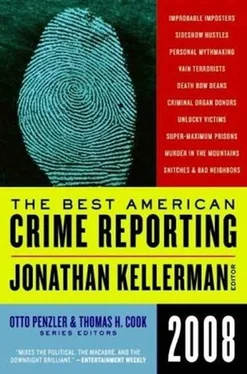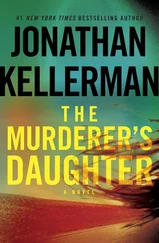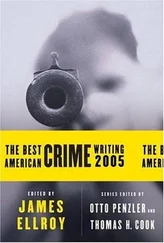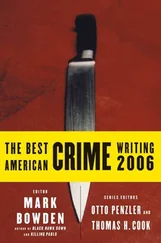In November 2007, student lawyers at the University of Denver’s Sturm College of Law filed a lawsuit in federal court on Silverstein’s behalf, claiming that his twenty-four years of solitary confinement amounts to cruel and unusual punishment. Silverstein and his supporters continue to protest his situation on his website, but his “no contact” status remains unchanged. In fact, he’s never had a chance to read “The Caged Life.” Warden Wiley denied him access to a copy of the article, claiming that its dissemination would compromise security because it mentions other inmates and contains information about escort procedures. I still receive letters from Silverstein, but it’s hard to imagine a day when we might actually meet.
Pamela Colloff: BADGES OF DISHONOR
FROM Texas Monthly
BEFORE THE CASE OF Border Patrol agents Ignacio “Nacho” Ramos and Jose Alonso Compean became a cause célèbre-that is, before there were calls for congressional hearings, high-level resignations at the Department of Justice, and presidential pardons- most didn’t make the newspaper at all. The facts of the story might never have come to light if not for a phone call between two middle-aged women who had grown up together in a village in Mexico. In late February 2005, Macaria Aldrete-Davila called her old friend Gregoria Toquinto from her home in Chihuahua and said that her son had crossed into the United States illegally near the West Texas town of Fabens. Border Patrol agents had pursued him, and he had fled on foot. An agent had shot him in the backside as he ran from them, toward the Rio Grande. Her son had managed to limp back to Mexico, but he still had a bullet lodged in his groin and was in need of medical attention. Gregoria, who was living in El Paso, listened to her friend’s story. Then she called her son-in-law, who happened to be a Border Patrol agent.
So began a Department of Homeland Security internal investigation that uncovered what appeared to be a straightforward case of two federal agents shooting at a man as he ran away and then concealing their actions. Investigators found that Osvaldo Aldrete-Davila had put his hands in the air and tried to surrender, but Compean-instead of apprehending him-had swung at him with the butt of his shotgun. Aldrete-Davila had bolted, and as he ran, Compean and Ramos had fired at him fifteen times, with Compean stopping to reload his Beretta as he tried to hit his mark. Neither agent announced the shooting over the radio or informed his supervisor of what had happened; the official report about the pursuit made no mention of their firing their weapons. And rather than secure the area so that evidence could be preserved, Compean had retrieved most of his spent shell casings and tossed them into a ditch. Only when questioned by investigators a month later did he offer the explanation that he and Ramos had acted in self-defense; Aldrete-Davila had been “pointing something shiny” that “looked like a gun.” A federal jury, which heard both agents’ testimony, rejected their version of events and convicted them on five out of six criminal charges, including assault, obstruction of justice, and civil rights violations.
That might have been the last word on the case, except that when talk radio shows, CNN’s Lou Dobbs Tonight, and conservative blogs picked up the story, they glossed over nearly all of the most damning facts presented at trial. Set against the backdrop of the national debate over immigration, a new narrative emerged, one in which Ramos and Compean were recast as “American heroes,” unjustly persecuted by a government that cared more about amnesty for illegal immigrants than about border security. The story line advanced by pundits and bloggers focused on Aldrete-Davila’s own illegal activity, since he had been ferrying a large load of marijuana when he had crossed paths with Ramos and Compean. (The agents had not known this when they fired their weapons; the marijuana was discovered only after the shooting, in a van Aldrete-Davila had abandoned when he fled.) The jury had taken this into consideration and had still chosen to hand down guilty verdicts. But the stark contrast between Aldrete-Davila’s fate and that of Ramos and Compean inspired outrage. Two Border Patrol agents were being sent to prison, while a dope smuggler-who had been granted immunity by federal prosecutors in exchange for his testimony-walked free.
This seemingly perverse logic provoked a backlash from conservatives who had grown frustrated with the Bush administration’s handling of border issues, prompting Ann Coulter to pen an acid assessment of the case titled “No Drug Smuggler Left Behind!” U.S. attorney Johnny Sutton, a Bush appointee, was excoriated for prosecuting the agents-and even branded “Johnny Satan” by Houston talk radio show host Edd Hendee-while bloggers hailed Ramos and Compean as “political prisoners” in a modern-day Dreyfus affair. Lou Dobbs opined about the case on more than one hundred broadcasts, calling it an “outrageous miscarriage of justice” and “an appeasement of the Mexican government.” Anti-illegal immigration activists like the Minuteman Civil Defense Corps staged rallies and raised money for the agents’ defense funds, and more than 370,000 Americans signed an online petition demanding presidential pardons. Republican congressmen known for their law-and-order credentials argued on the House floor that the agents were guilty of nothing more than “procedural violations” for failing to report the shooting, and U.S. representative Ted Poe, of Humble, commended them for their actions. “We ought to give both of these Border Patrol agents medals and send them out there to bag another one,” he said.
Entangled in the heated politics of illegal immigration, the facts of what had actually happened down by the river were cast aside, and the victim’s identity as a drug smuggler overshadowed the misconduct of the officers who had shot at him. Of the nearly 14,000 federal agents who patrol U.S. borders, it was Ramos and Compean who were held up as heroes. In an interview this summer, and in handwritten letters from prison that followed, Ramos was thoughtful and articulate about his time with the Border Patrol, longing for the days when he kept watch over the Rio Grande instead of a seven-by-thirteen-foot cell. Yet he was unrepentant about his actions on February 17, 2005. It was his bullet that had permanently maimed, and nearly killed, Aldrete-Davila, but Ramos felt that any prison time for him and his fellow agent was unwarranted. “If anything, Compean and I should have gotten an administrative punishment-if that,” he told me. “As for Aldrete-Davila, you know what? He got what he deserved.”
THIRTY-TWO MILES southeast of El Paso, Fabens hardly looks like the kind of place that could inspire a national media storm. The Wrangler jeans factory, once its biggest employer, moved to Costa Rica nearly two years ago, and now Fabens is just another fading West Texas town. Roosters crow in the heat of the afternoon; dust devils twist down Main Street. The train rattles by every now and then, on its way elsewhere. At lunchtime, farmers rest their white straw hats beside them at Margarita’s Café, trading news over warm bowls of caldo. Otherwise, the town is quiet. South of the blinking red stoplight, Fabens reverts to farmland, and cotton fields and pecan orchards stretch out for miles toward the Rio Grande. The jagged blue contours of mountains rise in the distance, across the river in Chihuahua-a constant reminder, from any vantage point in town, that Mexico is always near.
Ignacio Ramos arrived in Fabens as a recruit in 1995, when the local Border Patrol station was staffed by just twelve agents. (By the time Aldrete-Davila was shot a decade later, the number of agents had grown to more than eighty.) Fabens was transitioning from a quiet spot on the river into a busy crossing point, an unintended consequence of an initiative that the Border Patrol had launched two years earlier. Operation Hold the Line had succeeded in stemming the flow of illegal immigrants into El Paso, but it had not ended the problem. Human traffic had only shifted away from the city, moving southeastward to border towns like Socorro, San Elizario, and Fabens. As the tide of people and narcotics moved in, Ramos-and later Jose Alonso Compean, who was assigned to the Fabens station as a recruit in 2000-“worked the line,” patrolling the river for illegals and dope. Ramos would sometimes conduct surveillance for hours, concealed behind brush or in fields that had grown high with cotton. “I would have guys drop me off and leave me out there, and I would hide in the bushes or trees or canals,” he wrote to me from prison. “Sometimes it paid off, sometimes it wouldn’t, but it’s what kept the job interesting and a thinking game, as well. You were always trying to be a step ahead, or at least even with the dopers.”
Читать дальше












